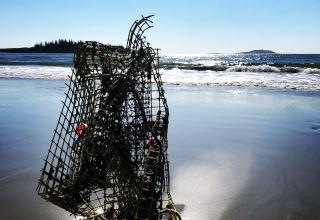
Two Marine escorts then led me and two other expats via jeep through the desert to the coast of the Persian Gulf. A separate Marine team had created a path from the meeting point through the desert with flags to guide the way. Trying to understand the process and potentially be of use, I asked the Marine escorts to explain what we should be looking for. They could have replied, “please ma’am, can you just sit quietly and let us do our job.” Instead, they described the different types of flags and the meaning of each one. When they couldn’t see the next directional flag in the desert, they said so. I have excellent distance vision, so I put it to good use. Several times during the desert drive, I was the first to see the flags and I yelled out their position from the back seat. The MSG were neither annoyed nor flustered; they gladly accepted my help and complimented my vision. We arrived at the makeshift processing center at the coast without getting lost or having to backtrack. As my escort explained, we, the expats, were then transferred to hovercrafts that took us to an awaiting ship. The MSG demonstrated an impressive balance of situational awareness, team communication and mission focus. Most impressive was their ability to juggle that day’s responsibilities while creating a sense of physical and psychological safety for with the expats being evacuated.
Team Coaching Implications: Cultivating Trust & Safety
The Marines in 1997 remain in my memory as a powerful example of how a team demonstrated psychological safety. As team coaches, we can further develop the ICF coaching competency around cultivating trust and (psychological) safety in the following ways:
Lay the foundation: Prior to a team coaching engagement, meet with the leader, each team member and stakeholders 1:1 to get acquainted and to identify concerns and expectations regarding the teach coaching engagement. We as coaches can begin to develop trust with each participant. In doing so, we not only demonstrate how people develop trust, but we also lay the behavioral groundwork for psychological safety in terms of having participants share without judgment or negative consequences.
Structure for safety and contribution: Co-creating team norms and rules is a key aspect of a team coaching engagement, exploring what it means to take risks, fail, be uncertain, be vulnerable and the perceived, actual, and desired repercussions of these actions. Ask team members what they need from the team in addition to what they can contribute. Shifting the question from needing to contributing can shift the nervous system to a more relaxed, less defensive/protective state. Participants shift their thinking to the skills/abilities they have to create an impactful team.
Leverage data: The Fearless Organization, based on the work of Amy Edmondson, has begun certifying coaches in The Fearless Organization Scan, a tool which provides team level psychological safety scores in four domains: attitude to risk and failure, inclusion and diversity, open conversation and willingness to help.
Demonstrate situational humility: Admit what you don’t know: the volatile, uncertain, complex, and ambiguous (VUCA) environments of knowledge work require coaches to acknowledge what they don’t know.
Use processes: Create forums for spontaneous team sharing, learning and support. Some team members may be happy to share, but are more inclined to write it down than speak up in a group. They may also want to capture and share reflections between coaching sessions.
Download Article












